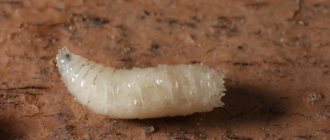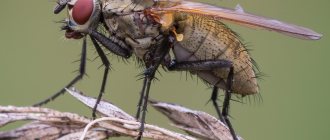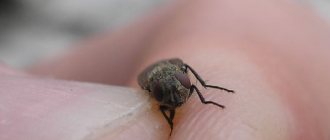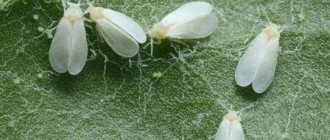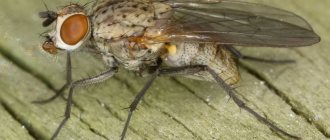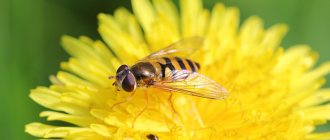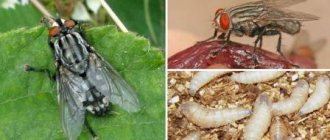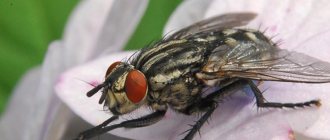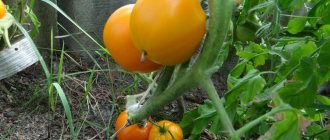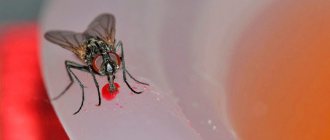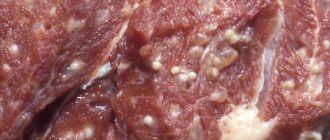The African melon fly (Bactrocera cucurbitae (Coquillett)) is a pest that attacks the fruits of melon crops, making them unfit for consumption. As a result of the vital activity of this insect, crop loss can be 70-100%. The pest has a fairly long life cycle; it is capable of repeatedly breeding offspring per season. Harm to crops is caused by adults and their voracious larvae.
Description of appearance
The pest looks like a fly and has a different color. A small insect up to 7 mm long. The color is yellow with round dark spots. The body is covered with hairs. The wings are transparent, variegated, with yellow transverse stripes. A photo of the melon fly is presented below. The eggs are milky white, oblong. The larva is up to 10 mm long, cylindrical in shape, without legs, and resembles a caterpillar. On the last segment two tubercles stand out.
What types of houseflies are there?
The concept of “housefly” cannot be assessed unambiguously. Considered from a biological perspective, the housefly is a separate species with its own description. From the point of view of the average person, any insect that has wings flies around the house. There are ordinary ones, gray or black in color, which, when the windows are open in the summer heat, live on window sills or ceilings, irritating the ear with their annoying buzzing. The housefly is one of the varieties of the housefly, which is distinguished only by its slightly larger size. And there are flies with a beautiful green color and smoky wings, and this is where you should be wary. The green (carrion) fly is an inhabitant of very polluted areas, feeds on corpses and lays its eggs there. It is a carrier of various infectious diseases.
Lifestyle
The puparia overwinters in the soil where infected crops grew. In spring, when the temperature rises to +15 degrees Celsius, an adult melon fly appears. For about a week, adults feed on flower nectar and fruit juices. Summer time coincides with the flowering period of melons. The first mating season lasts up to one month. In total, 3 generations of melon flies are replaced during the season.
On a note!
After mating, the females begin laying eggs. Do this one egg for each fruit. Each female lays up to 120 eggs. The process lasts 30 days. Under favorable conditions, after 3-4 days, larvae appear, penetrate into the pulp of the fruit, and begin to actively feed on juices.
The maggot develops for about 18 days, then leaves the fruit, falls to the ground, and pupates. After a few days, an adult fly appears, ready to reproduce. The pupal phase lasts 10-20 days in summer, 45 days in autumn. During the puparia phase it overwinters.
What kind of insect is this?
Mining flies (or flies) are a whole family Agromyzidae (lat.), which includes about 3000 species. All of them are dipterous insects. These are small flies; the massive thoracic region is clearly visible in the structure. Other distinctive features of the family are a wide abdomen, short legs and transparent wings, slightly sparkling in the sun.
The greatest species diversity was noted by biologists in Germany. There are 350 species of insects found in this country. In Russia, in regions with a temperate climate, there are much fewer of them - about 100. The most common of them are:
- herbivorous – Liriomyza strigata;
- polyphagous – Phytomyza horticola;
- chrysanthemum leaf – Phytomyza syngenesiae;
- nightshade – Linomyza bryoniae, etc.
These species infect cultivated plants, causing harm to agriculture and ornamental floriculture.
Life cycle of an insect
Flies are characterized by bisexual reproduction: individuals of different sexes mate, after which, after some time, the female lays a clutch. She places her special organ - the ovipositor with a sharp end - deep into the leaf blade of plants. After such punctures, light green dots remain on its surface, which fade over time. Moreover, only 15% of the holes created in the leaves are needed for laying: all other injections serve to feed the adult miner fly.
When 2 to 5 days have passed, the larvae are born. In order to grow as quickly as possible and move to the next stage of development, they begin to feed heavily. To do this, the larvae gnaw the leaves of plants, creating a branched system of passages in them, which are called “mines.” This is where the name of the whole family came from.
When the resources of one leaf are exhausted, the larva begins to move along the stem and branches of the plant in search of a new place to feed. After 2 weeks, it is time for pupation. The larva gnaws the surface of the leaf, crawls out and moves to the ground. There, under a thin layer of soil, it will become a pupa, from which a new fly will then emerge. In total, the transformation cycle from egg to adult insect takes 25 days (at an air temperature of 20 °C).
Sabotage
Larvae and adults pose a threat to melon and pumpkin crops. This dangerous quarantine pest parasitizes the fruits and seeds of the following crops:
- melon;
- common watermelon;
- common cucumber;
- snake melon;
- wild melon (Cucumis trigonus);
- squirting cucumber;
- pumpkin.
The percentage of crop damage in places where the melon fly is spread reaches 70-100%. The larvae make passages in the pulp, making it unfit for consumption. Bacteria penetrate there and rotting processes begin.
Melon fly
Adult flies make punctures in the melon, from which juices appear, which the adults feed on. With numerous punctures, the fruit begins to rot, infection penetrates into the holes, and fungal diseases develop.
On a note!
The first sign of the presence of a dangerous pest is the presence of dark spots, tubercles on the skin of a melon or other fruit. In the process of parasitism of the larvae, rotting begins from the inside.
How to detect a pest in melon beds
The melon fly is a pest that is quite difficult to identify at the initial stage of infestation. It is possible to determine when signs of the vital activity of these insects appear. They are characterized by small dots, tubercles on fruits and shoots of plants, in places where they are punctured by females. Fungi and bacteria enter open wounds, which leads to rotting and darkening of the puncture sites.
At the stage of emergence of the larvae, the signs become clearly pronounced. The fruits lose their elasticity and begin to rot quickly. Moreover, this happens already 4-5 days after the appearance of the larvae.
Can I eat contaminated melons? The insect does not pose a danger to humans. It does not carry dangerous diseases and does not bite. But it is not recommended to eat fruits in which melon fly larvae have settled inside. In the process of life, they damage the pulp and seeds, which causes the development of rot in the damaged areas.
In affected fruits, the pulp loses its elastic consistency and begins to emit an unpleasant odor. Eating affected melons leads to disruption of the digestive system.
Methods for controlling melon fly
To destroy pests, several control methods are combined, and preventive measures are required.
Agrotechnical methods include:
- deep plowing of the soil after harvesting, before sowing new beds;
- compliance with crop rotation;
- the use of hybrids that are resistant to damage by larvae, diseases, and fungal infections;
- destruction of the remains of the infected plant by burning.
Before planting seeds in the soil, pre-soaking in chemicals is recommended. Treatment of melon against melon fly with insecticidal preparations is allowed at the stage of appearance of the first leaves. It is forbidden to spray formed fruits with a poisonous agent. Some chemicals are introduced into the soil along with fertilizers. Do not use toxic substances during the flowering period of crops, 20 days before harvest.
Melon diseases: methods of their treatment and prevention
Fusarium wilt
The disease is caused by a fungus and appears more often on late-ripening melon varieties. The fruits remain edible, but lose their juiciness and sweetness and are stored worse. The disease appears on the first true leaves and at the stage of fruit ripening. The leaf system “burns out” and gray spots appear on it. If the infection is severe, the plant dies within a week after infection.
Fighting methods:
- immediately destroy diseased plants;
- do not overdo it with watering;
- Thorough digging of the soil in autumn is required;
- Place seeds for 5 minutes before planting. in formaldehyde solution (40%);
- the beds should be high;
- Spray the green melons with a solution of potassium chloride during the appearance of buds.
Gray mold
Another fungal disease that appears in cold conditions (+15 degrees C.) and high humidity. The ovaries of melon fruits become soft and watery, covered with gray fluff. The disease can live in the soil for more than 2 years.
Fighting methods:
- do thorough weeding;
- check plants for the presence of disease and immediately remove infected ones;
- spraying: per 10 liters of water 1 gram of zinc sulfate, 10 grams of urea and 2 grams of copper sulfate.
Downy mildew
This problem is caused by a type of fungus. It parasitizes early mature leaves and appears as bright yellow-green areas. Over time, these areas grow. If the weather is very humid, then at the bottom of the affected leaf you can see a purple-gray coating - fungal spores.
Fighting methods:
- Before planting, warm the seeds in a closed container in water at a temperature of at least 45 degrees C. at least 2 hours;
- treat the seeds before planting with potassium permanganate (1% solution, soak for 20 minutes).
Cucumber mosaic
A viral disease of plants, characterized by a strong collapse of leaf veins and, as a result, a noticeable increase in its relief. The plant stops growing and bearing fruit.
Fighting methods:
- timely weeding;
- use of pure fertilizers;
- treating seeds before planting with a solution of trisodium phosphate or potassium permanganate;
- Spray the plants with a 3% farmiod solution.
Root rot
Affects weak plants. Their stem and roots gradually become brown and gradually become thinner. If the fruit is already growing, it may have rotten insides (dark spots inside the melon), if it has not yet grown, it may never grow.
Fighting methods:
- be careful with watering: you don’t need to water a lot;
- disinfection of seeds before planting in formaldehyde.
White spot (septoria)
This fungus manifests itself as round, whitish spots. Further, the centers of these spots darken (the fungus multiplies). The disease spreads well in damp conditions.
Fighting methods:
- deep digging of soil between plantings;
- destroy diseased plants immediately;
- spray the plants with Bordeaux water (1% solution).
Ascochyta blight
The most destructive disease of melons caused by a fungus. Affects the root collar of plants. At first these are just faded spots, then they increase in size and spread to the entire neck. The fruitfulness of the plant is significantly reduced. It can affect already mature fruits. They turn black and dry out. Favorable soil for the disease: low temperature combined with high humidity.
Fighting methods:
- deep autumn plowing;
- thorough removal of all plant debris (especially affected ones);
- use of potassium-based fertilizers, treatment of crops with Bordeaux water.
Anthracnose (scarden)
Anthracnose of melon is easily determined: round brown-pink spots appear on the leaves. Over time, they grow, and through holes appear in their centers. Such leaves curl and dry out. The same blemishes can appear on the fruit itself (the pulp and skin of the melon will have brown spots), leading to its deformation and rotting.
Fighting methods:
- carefully and promptly remove all plant remains from the garden bed;
- maintain correct crop rotation;
- do not overdo it with watering;
- spray plants with Bordeaux water or sulfur powder.
Effective methods
Before flowering, the crop can be sprayed with chemicals. The most commonly used are Fufanon, Karbofos, Iskra, Aktara, Decis Profi, Arrivo. Protection lasts for 20 days. The solution is prepared immediately before processing the plants. You can buy the drug in a specialized hardware store. Price per dose from 10 rubles.
Preparations for melon fly
On a note!
From folk remedies, you can treat the bed with a solution of ammonia - 10 5 ml of ammonia per 10 liters of water. You need to water the soil, making sure that the product does not get on the leaves. Repeat the procedure twice a month. The pungent odor repels adults, but does not affect the larvae.
If pests are detected, damaged fruits should be destroyed. To prevent infection of the future crop, agrotechnical control methods are used.
Cherry fly - how to identify it?
This miniature fly is difficult to see; the presence of a pest in the garden can only be determined by the presence of wormholes in the berries of cherries. The following signs indicate that there is a pest in the garden:
- Black dots are visible on the berries that begin to fill, these are traces of punctures of the skin by the insect's ovipositor. The fly left an egg in this place, from which a larva will appear after a while.
- Later, a depression forms at the puncture site, and the berry begins to rot.
- The presence of a worm in a berry can be determined by external signs: the pulp becomes soft, and the skin acquires a matte tint, its characteristic shine is lost.
- When you break the berry inside, you can see a small white worm.
You can protect your crop from the pest if you take care of its detection in advance. To do this, in the spring, when flies begin to emerge after wintering, sticky traps are made. The simple device consists of a small piece of plywood or thick cardboard coated with yellow paint and a sticky substance.
This can be any glue that does not dry for a long time, for example, ALT. The trap is attached to a tree and observed. If more than 2 flies are detected per day, then their flight has begun, and the trees need to be treated with insecticides.
Appearance and stages of development
The cherry fly can be easily recognized by its appearance. It is small, no more than 5.5 mm in size, with a shiny black body, yellow paws and head. She has green eyes and an orange shield. The insect belongs to the variegated wing family.
If weather conditions are favorable, the insect completes its full life cycle in one year.
Pupae turn into adults (imago) in spring when the soil temperature reaches 10⁰C. This happens in mid-May, when the acacia begins to bloom. Before laying eggs, females need increased nutrition.
Juice of berries, secretions of aphids, wound acid of leaves make up their diet. After 14 days they begin to mate and lay eggs.
The flight of the cherry fly continues in June and early July, so it can destroy a significant part of the cherry and cherry crop. Having completed laying eggs, the females die.
White worms 0.5 mm in size - fly larvae - emerge from eggs about a week after laying. Feeding on the pulp of the berry, it moves deeper into the seed. The larval stage lasts 15-20 days. During this time, the pest increases significantly in size, reaching 7 mm, and leaves the berry. Once on the soil, it pupates.
In June, the first pupae appear, but do not develop this season, since they need to undergo cooling to complete the life cycle of development. Therefore, the insect in the pupal stage remains unchanged until next spring.
Preventive measures against cherry fly
The pest can be destroyed using chemicals - insecticides. But for early cherries this method cannot always be applied, since the ripening of the berries very often coincides with the beginning of the flight of the fly.
Adherents of organic farming use folk remedies and organic preparations. Everyone can choose a suitable method of protection from the front sight.
A good result comes from the comprehensive use of protective equipment. In addition to treating trees with pesticides and biological products, it is recommended to carry out the following preventive measures in the garden:
- remove all spoiled berries from the trees; they may contain larvae that will become flies next year;
- remove all carrion under the trees, remove it from the site or bury it to a depth of 0.5 meters;
- If you dig up tree trunk circles within the crown in late autumn and early spring, the insect pupae will die from frost or become food for birds.
Biological and chemical agents
The fight against cherry flies involves timely treatment of plants with insecticides. It is recommended to use them during the mass emergence of the pest, in the second half of May. Secondary treatment is carried out after two weeks. At this time, females begin laying eggs.
For treatment, insecticides intended against flying pests are used. It is advisable to carry out secondary treatment with another means, this will prevent insects from becoming accustomed to the toxic substance and increase efficiency. The following chemicals are used:
- Confidor;
- Aktellik;
- Calypso;
- Maxi
An alternative to chemical preparations are microbiological ones. These drugs are not harmful to the environment and can be viral, fungal or bacterial.
To treat trees against cherry flies, it is recommended to use Nemabakt, Fitoverm, Lepidocid. Controlling pests and beneficial insects requires a lot of knowledge and effort.
The use of both chemical and biological protection agents at the same time is not advisable, as this can lead to the death of beneficial insects.
Folk remedies
In cases where plants cannot be sprayed, the following folk remedies are used:
- in April, cover the tree trunk circles with agrofibre, this prevents flies from flying out, since the pupae will remain under it;
- They treat trees with strong-smelling solutions based on herbs: tobacco, wormwood, garlic, pine needles;
- hang insect traps.
African melon fly
The official name is Bactrocera cucurbitae coquillett. Lives in tropical countries, parasitizes all year round. Distributed in Africa, Asia, USA, Oceania. Affects 125 species of plants from the pumpkin family:
- melon (Cucumis melo);
- giant pumpkin (Cucurbita maxima);
- watermelon (Citrullus lanatus);
- cucumber (Cucumis sativus);
- pumpkin (Cucurbita pepo);
- citrus fruits (Citrus);
- papaya (Carica papaya);
- mango (Mangifera indica).
Symptoms of damage are punctures in the peel, signs of rotting. Spread with infected fruits and soil. The fight is carried out using combined methods.
Chemical sterilization of insect pests
Work to reduce the fertility or completely stop the reproduction of insects began in the late 40s of the 20th century. Soviet researcher I.A. Rappoport was one of the first to discover the sterilizing abilities of certain chemical substances acting on insects. A little later, this technique was developed in the USA and other countries. Not only crop protection specialists, but also oncologists have become actively interested in chemical compounds that block the growth of unwanted cells.
The most effective for sterilizing insect pests were preparations based on thiophosphoric acid triethylenimide and phosphoric acid triethylenimide. Thus, to protect tomatoes from the Drosophila fly, by adding sterilized individuals to the pest population (25 specimens per mature one), it was possible to reduce the Drosophila population size by 82% in two months. Chemically sterilized insects have also been used extensively against the American white butterfly and boll weevil.
The effect of chemical compounds to sterilize insect pests was manifested through delayed development of gonads, death of formed eggs or sperm, as well as the ability to control the fertilization process and other results to reduce the population. Chemical sterilization of insect pests was carried out taking into account the drug used and the stage of development of the pest. Pupae, for example, were placed in chemical solutions for some time, larvae received their dose in specially created synthetic environments, adults were most often treated by contact, through the surface of the integument or limbs.
However, further research has shown that some chemical compounds used to sterilize insect pests can be toxic and even carcinogenic to warm-blooded fauna. This has slowed the wider adoption of chemical sterilization and left scientists with a challenge: finding safe mechanisms for its use.
Processing means
To prevent the occurrence of diseases and protect plants from pests, it is necessary not only to observe crop rotation, not to plant melons in heavy soil, but also to treat the seeds in solutions of potassium permanganate, formalin, and “Fundazol”.
Having discovered the first signs of the disease, melons are sprayed with herbal infusions and various folk remedies are used. If their treatment is ineffective, fungicides are used in the form of colloidal sulfur, Bordeaux mixture, and Fitosporin.
If pests appear on melons, other methods are needed to cope with them. Insecticides destroy melon aphids, spider mites and wireworms. Chemical preparations, “Bi-58”, “Aktara”, are most effective in combating parasites. But after spraying them, the fruits cannot be consumed for three weeks.
Melon pests
Various insects love melons. They land on the lower part of the leaf in entire colonies and quickly rid it of water and juice. Microscopic aphids destroy the beds in a matter of days.
To prevent the appearance of dangerous pests, melons are sprayed with Karbofos, biological preparations such as Actellica, solutions of tobacco dust and laundry soap. From the area where melons were grown, it is necessary to pull out all the roots and remove the remnants of the stems.
Melon fly
A particular danger to both the fruits and seeds of the crop is the insect, invasions of which are observed in India, North Africa, and Iran. Not long ago, the parasite settled in Transcaucasia and is found in the southern and even northern regions of Russia. The melon fly can destroy half the crop, since not one, but three generations of insects appear per season.
The offspring develop well and grow quickly at high temperatures. The larvae of the parasite, which resemble worms in appearance, do not have legs, live for at least a week and feed on the juice of fruits and gnaw seeds. Then they leave their place and, going 12 cm deep into the ground, turn into pupae.
To understand how best to combat the melon fly, you need to know what this parasite looks like when the next generation appears. Females lay up to 120 eggs, for which they gnaw holes in the fruits.
The insect is distinguished by wings covered with yellow transverse stripes. The length of its body reaches a centimeter and even a little more. The fly eats not only juice, it also loves sweet pulp. Viruses and fungi are sent to the affected melon, which provoke the development of diseases.
The parasite, which has wings with four stripes, destroys both cucumbers and watermelons. The danger to humans comes not from the imago, but from the fruit affected by it, which begins to rot. After consuming it, diarrhea may begin, and prolonged diarrhea can lead to dehydration.
To prevent damage to plants by the melon fly:
- Before planting, seeds are dipped in a solution of potassium permanganate.
- When leaves and then lashes appear, the chestnut tree is treated with “Rapier” herbicides.
- When the first flowers form, melons and melons are sprayed with insecticides.
"Kemifos" helps to drive away the pest from melon beds. The contents of one ampoule are dissolved in half a bucket of water. This composition is enough for an area of 5 square meters. meters. Karbofos helps to cope with the melon fly that appears at the beginning of flowering. Mix 3 tbsp in 10 liters of water. spoons of the substance. After the second treatment, the parasites leave the beds. Insects die when repeatedly sprayed with Fufanon.
The crop should not be planted in one place for several years; you need to adhere to the rules of agricultural technology and observe crop rotation.
Melon fly larvae die en masse when plants are sprayed with Confidor. Fruits covered with spots should be picked and burned. Under no circumstances should they be eaten.
Melon aphid on melons
A microscopic insect, which has a brown, black, and green color, having settled at the bottom of the melon leaves, spreads over the entire surface. Aphids literally destroy melon beds in just a few days. In one season, 2 dozen generations are hatched. To reduce the spread of parasites throughout the tower, it is necessary to weed the area in a timely manner.
The juice from the ground parts of the plant is sucked out not only by adults, but also by melon larvae, the melon becomes insufficiently moist, the stems dry out, and it dies.
In humid and hot weather, parasites appear as early as June. If the fruits have already appeared, the pest drinks moisture from them. Melon larvae and adults are also dangerous because they spread viruses and bacteria, which provoke the occurrence of destructive diseases. Not all gardeners know how to treat melon plantings.
See also
Description and technology of growing Vietnamese melon, varieties
Read
Folk remedies in the form of spraying with infusions made from garlic, decoctions of horseradish, tansy, onion peels and mustard help cope with the parasite when the insects have just settled on the leaves, and there are few of them in the melon beds. Otherwise, the plants will have to be treated with insecticides in the form of Decis, Intavir, or sprayed with the biological preparation Fitoverm. One ampoule of the product is poured into 5 liters of water. Melon plantings are covered with cellophane for a day.
Many gardeners are interested in whether it is possible to eat fruits after processing. When using herbal infusions and other folk remedies, consuming melons is not prohibited. If the crop was sprayed with insecticides, you will have to wait a month.
Spider mite
Female arthropod insects, which have a body length of no more than half a millimeter, overwinter burrowed into the ground, on harvested tops and weeds. In summer, spider mites settle in:
- on buds;
- ovary;
- on young shoots;
- from the bottom of the leaves.
Parasites multiply quickly, leave the affected plant and move to a healthy melon. The presence of an insect is indicated by the appearance of white dots and cobwebs. Over time, the leaves turn yellow, become covered with red spots and dry out. Mites infect melon crops with diseases of viral and bacterial origin.
To prevent parasites from reaching the melon beds, before planting the seeds, the ground must be treated with lime, and the first leaves must be treated with Fitoverm and Bi-58.
Wireworms
Often larvae appear on tower trees, which have a rigid body and three pairs of legs. They make a clicking noise when they roll over onto their back. Wireworms chew through the lower part of the stems and roots of melons, and the crop quickly dies. Parasites love moisture, and when the top layer of soil dries out, they move deeper into the ground. The pests spend the winter there, and in the spring, when they get out, they begin to eat the seeds.
To prevent wireworms from appearing in melon beds, you must:
- Remove weeds.
- Pull out wheatgrass by the roots.
- It's good to dig up the ground.
Parasites love acidic soil; before sowing melons, the area is limed. Wireworms react negatively to fertilizers that contain nitrogen. When insects appear, melon beds are sprayed with Aktara.
Broomrape
A gray plant with bluish flowers and stems covered with yellow scales is very dangerous for melons. The parasite destroys entire plantings in the countries of Central Asia and in the southern regions of the Volga region. The Egyptian broomrape feeds on juice, clinging to the roots of melons with its suckers.
To cope with the pest, it is recommended to combine melons with rice crops, carefully weed the beds, spray the melons with dichlorophenoxyacetic acid; the parasite dies even with a small concentration of the substance.
Gnawing cutworms
If you don’t dig up the soil in the fall, don’t remove the remains of herbs and shrubs, and don’t observe crop rotation, pests will appear that quickly make short work of the melon stems. Caterpillars of moths, which are called cutworms, damage the root collar of melons. Female insects lay hundreds of eggs.
Individuals of the first generation feed on weeds, watermelons, and melons. Adult caterpillars crawl into the ground, where the pupae appear. The second generation butterflies emerge in June and live until September. Having accumulated nutrients, they overwinter normally, but only if the ground is well covered with snow.
To get rid of cutworms, before the buds appear, the beds are sprayed with hexachlorane dust, and baits are installed to help catch the butterflies.
